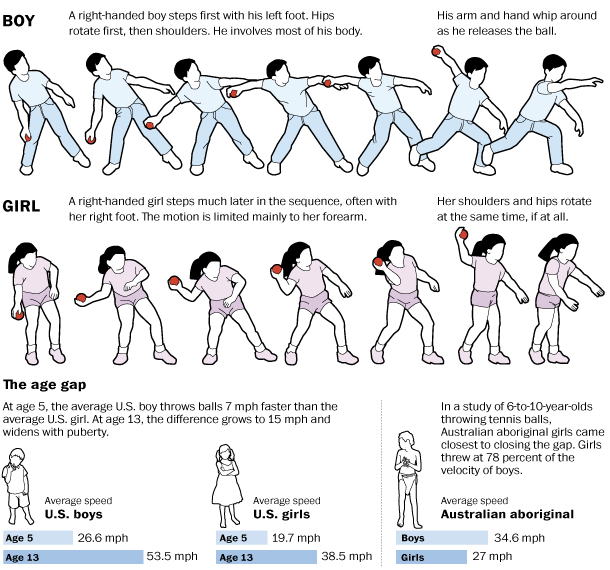
Fig.1 Iris Marion Young.jpg
Iris Marion Young (Fig.1) – Born in New York City (2 January 1949 – 1 August 2006), she was a philosopher, who wrote about different topics and also a political theorist and feminist. She graduated with honours at Queens College. Her interests were in the sphere of the nature of justice and the social difference. She wrote notably about feminist phenomenology, ethics and social justice, democratic theory, global justice and security. The political activism was very important for her and also as a professor of Political science at the University of Chicago, she motivated her students to be part of their communities. (Iris Marion Young, 2016),(Ferguson and Nagel, 2010)
While talking about the behavioural differences between males and females the essay tries, with the help of different research papers, to define where lies the reason for the old saying “you throw like a girl”.
The author looks at different cases and in the end is drawn to the conclusion that the main reason for this proverb, and other specific actions and behaviours have their roots not in a physical manner, like we might assume. Rather those differences are much deeper and can be attributed to something a bit more interesting – how males and females occupy space. The paper tries to prove that girls from an early space are thought to be fragile – to be careful, considerate and in general feminine [pp. 43-44]. This type of behaviour starts manifesting itself in later stages in life and is ultimately one of the reasons why girls are presumed to be the weaker of the sexes – this is not directly said by the author but rather hinted in the manner of speaking towards the end of the essay.
Going back to the thoughts of how women and men occupy their space differently. In the end the main reason that we can say girls throw like, and excuse me for repeating myself, “a girl” can be attributed to the way how girls and boys occupy their personal space. Girls perceive their personal space as a closed and limited, while boys tend to extend out of their their surroundings and perceive it more as an open type of space [pp. 39].
“He concluded that females tend to emphasize what he calls “inner space,” or enclosed space, while males tend to emphasize what he calls “outer space,” …”
This is an interesting rhetoric and it can make us think about how we perceive space – even more as interior designer we take care and create spaces for other people. Taking research like this one into account, we can start think on a broader scale how we can focus our designs to be more effective. Case and point – we should think about our “target audience” – “Particular group of people, identified as the intended recipient of an advertisement or message” (Business Dictionary, 2016). In other words – a target audience is the people we are designing for. By finding our specific audience and the purpose of our space, we can focus on little details that would make the interior a better and pleasant location for our “audience”. Another example – if we try to create a space targeted at males we should focus on a more symmetrical arrangement as this proves more pleasant for that sex, while a more asymmetrical and dynamic form is more appealing to the female side. (Izhaki, 2016)
 Fig.2 w-Girlthrow.jpg
Fig.2 w-Girlthrow.jpg
 Fig.3 7047626-3×2-940×627.jpg
Fig.3 7047626-3×2-940×627.jpg
Questions:
- Can you think of other examples where the different sexes would behave differently in such a way that it can influence our designs?
- Do you agree with the statement that this manner of behaviour has its routes from patriarchal oppression?b
New words:
- motility – contraction of the muscles that mix and propel contents in the gastrointestinal (GI) tract.
- comportment – behaviour; bearing
REFERENCES:
Iris Marion Young (2016) in Wikipedia. Available at: https://en.wikipedia.org/wiki/Iris_Marion_Young (Accessed: 7 November 2016).
Ferguson, A. and Nagel, M. (2010) Dancing with Iris: The philosophy of Iris Marion Young. Available at: http://ndpr.nd.edu/news/24487-dancing-with-iris-the-philosophy-of-iris-marion-young/ (Accessed: 7 November 2016).
Bussiness Dictionary (2016) in Available at: http://www.businessdictionary.com/definition/target-audience.html (Accessed: 7 November 2016).
Izhaki (2016) Available at: http://ux.stackexchange.com/questions/45453/is-there-data-supporting-the-theory-that-women-prefer-rounded-borders (Accessed: 8 November 2016).